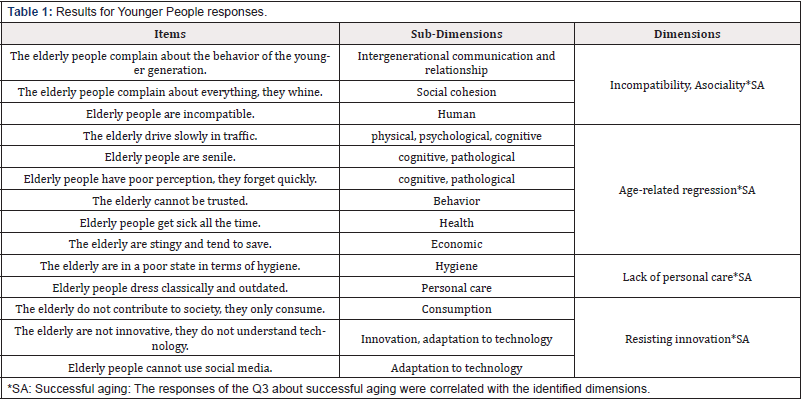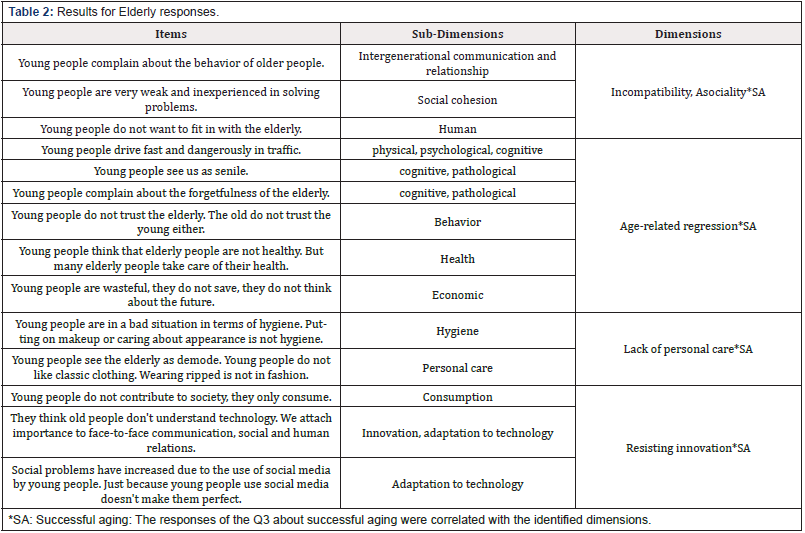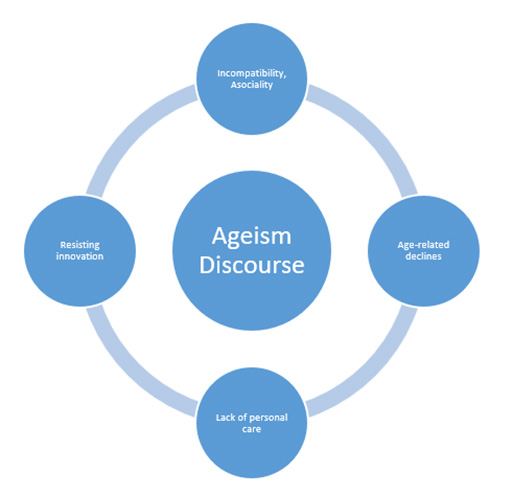Research Article 
 Creative Commons, CC-BY
Creative Commons, CC-BY
Effects of Ageism Discourse on Successful Aging
*Corresponding author: Fahri Özsungur, Department of Economics and Administrative Sciences, Mersin University, Turkey.
Received: January 11, 2022; Published: February 22, 2022
DOI: 10.34297/AJBSR.2022.15.002128
Abstract
The aim of this study is to reveal the effects of ageism discourse on successful aging. The study was carried out with 49 elderly and 49 young people living in Yenişehir, Mersin, Turkey. The snowball sampling method was adopted in the sample. Of the elderly participants, 27 were women and 22 were men. 4 women and 6 men were working in any job and the others were retired. There were 11 people in the sample who were 80 years or older. 12 individuals (7 women, 5 men) lived alone, and the others lived with their families. This study shows that four basic dimensions are effective in the perceptions of elderly and young individuals about each other and about aging. On the other hand, these four factors were identified as related factors in the questions about successful aging. In the answers given to the questions, the common factors affecting successful aging were determined as the dimensions of ageism discourse.
Keywords: Aging discourse; discrimination discourse, ageism, successful aging, Geotechnology
Introduction
Discourse is a current issue that affects social, economic, legal, political and many systems in today’s World [1-4]. The emergence of the pandemic, technological and cyber developments threaten the personal information security and privacy of individuals [5-6]. Psychological, cognitive, and physiological regressions/declines that occur with increasing age increase this safety risk even more [7-8]. Ageism discourse can increase the psychological effects that individuals are exposed to in the aging process. Therefore, examining the effects of ageism discourse on successful aging is especially important in the period of COVID-19. The aim of this study is to reveal the effects of ageism discourse on successful aging.
Methods
Adopted Research Method
Phenomenology, one of the qualitative research methods, which is an important method in dealing with social problems in depth, was adopted in the study [9]. This method provides answers to the research questions determined at the beginning with the data ob tained from the participants through the interview [10]. In addition, since phenomenology is a qualitative research method, it can help to eliminate the negative aspects of common method biases caused by quantitative research data [11]. Because the participants can answer the question in a limited scope in quantitative research.
Ethical Rules
A participant consent form was presented to the participants regarding the purpose, title, content, possible risks, and other ethical issues of the study. This form was explained in detail to all individuals. 32 young and 49 elderly people who did not want to participate in the study were not asked any questions and were excluded from the study.
Inspiration Point and Sampling
Ageism is increasing day by day due to the gradual increase in the elderly population and the regressions in old age [12-15]. Ageism causes discourse due to the cyber and technological developments and declines related to aging [13-15]. The effects of these discourses on successful aging in aging constitute the subject of the research. In this context, the research questions were determined as follows: What are the effects of ageism discourse in aging on successful aging? In this context, what are the dimensions/factors of Ageism Discourse? After these questions were determined, the target sample group for the research was determined. As the age group most affected by the discourse, individuals aged 65 and over were determined as the target sample group. The age range of 15 to 25 age was chosen for the young sample. It is very difficult to reach the target sample in the qualitative research method. Therefore, the target sample should be limited.
Results
Demographic Variables
The study was carried out with 49 elderly and 49 young people living in Yenişehir, Mersin, Turkey. The snowball sampling method was adopted in the sample. Of the elderly participants, 27 were women and 22 were men. 4 women and 6 men were working in any job and the others were retired. There were 11 people in the sample who were 80 years or older. 12 individuals (7 women, 5 men) lived alone, and the others lived with their families. The age range of young individuals was between 15 and 25. 36 of these participants were university students, and the others were high school and secondary school students. Twenty-four of the young participants were female and 25 were male.
Analysis Method
Participants were asked questions as indicated in the appendix. These questions were determined in accordance with the literature review, research question, and the purpose of the study. According to the findings obtained from the qualitative data, 1598 unique sentences and 9246 words were analyzed. This analysis consists of a classification of concepts, determination of upper and lower headings, data extraction, classification, merging, linking, determination of dimensions, and output stages [16-18]. The findings were presented to two separate committees consisting of seven members each. Each committee voted on the consistency of the results and links. The following tables were created with the results obtained. Results for younger people responses are presented in Table 1 & 2.
Conclusion
A three-dimensional structure related to ageism has been identified in the literature (stereotypes, prejudice, discrimination) [19- 24]. This study shows that four basic dimensions are effective in the perceptions of elderly and young individuals about each other and about aging. On the other hand, these four factors were identified as related factors in the questions about successful aging. In the answers given to the questions, the common factors affecting successful aging were determined as the dimensions of ageism discourse.
The fact that the discourse about aging resulted in a significant level of ageism for both groups reveal the importance of the perception and discourse of aging. The fact that the findings create a four-factor structure that affects the perception of aging and causes the discourse of ageism can provide a significant improvement in the interaction between the elderly and young people. As shown in Figure 1, ageism discourse creates a four-factor trajectory. It is recommended that practitioners and policymakers develop projects that will eliminate the negative effects of these four factors. In addition, the application of these findings in different samples may help to reveal cultural differences.
Acknowledgment
I dedicate this study to our mothers who never get old.
Appendix.

References
- Mills S (2004) Discourse
- Howarth D (2000) Discourse. Mc Graw-Hill Education, UK.
- Fairclough N (1995) Media discourse 9-14.
- Gill R (2000) Discourse analysis. Qualitative researching with text, image, and sound 1: 172-190.
- Pranggono B, Arabo A (2021) COVID‐19 pandemic cybersecurity issues I.
- Radanliev P, Roure DCD, Van Kleek M (2020) Digitalization of COVID-19 pandemic management and cyber risk from connected systems. IEEE internet of things News.
- Özsungur F (2020) Gerontechnological factors affecting successful aging of elderly. The Aging Male 23(5): 520-532.
- Özsungur F (2020) Network Security and Privacy in Social Work. Journal of Sensor Networks and Data Communications1 (1): 1-4.
- Giorgi A, Giorgi B (2003) Phenomenology Sage Publications, Inc.
- Moran D (2002) Introduction to phenomenology
- Sokolowski R (2000) Introduction to phenomenology Cambridge university press.
- Bytheway B (1994) Ageism Mc Graw-Hill Education, UK.
- Bytheway B (2005) Ageism Cambridge University Press 338-345.
- Palmore E (2001) The ageism survey: First findings. The gerontologist 41(5): 572-575.
- Iversen TN, Larsen L, Solem PE (2009) A conceptual analysis of ageism. Nordic Psychology 61(3): 4-22.
- Seaman CB (2008) Qualitative methods. In Guide to advanced empirical software engineering Springer London 35-62.
- Smith R, Smith L (2018) Qualitative methods. In Research methods in human rights. Routledge 70-93.
- Bergman MM, Coxon AP (2005) The quality in qualitative methods. In Forum: qualitative social research= Forum qualitative Sozialforschung: Freie Univ Berlin 6(2): Art-34.
- Dovidio JF, Hewstone M, Glick P, Esses VM (2010) Prejudice, stereotyping and discrimination: Theoretical and empirical overview. Prejudice, stereotyping and discrimination 3-28.
- Fiske ST (1998) Stereotyping, prejudice, and discrimination. In D. T. Gilbert, et al. (Eds.), The handbook of social psychology Mc Graw-Hill 357-411.
- Correll J, Judd CM, Park B, Wittenbrink B (2010) Measuring prejudice, stereotypes, and discrimination. The SAGE handbook of prejudice, stereotyping and discrimination 45-62.
- Dovidio JF, Gaertner SL (1986) Prejudice, discrimination, and racism Academic Press.
- Dovidio JF, Glick P, Hewstone M (2010) The SAGE handbook of prejudice, stereotyping and discrimination. The SAGE Handbook of Prejudice, Stereotyping and Discrimination 1-672.
- Nelson TD (2009) Handbook of prejudice, stereotyping, and discrimination Psychology Press.






 We use cookies to ensure you get the best experience on our website.
We use cookies to ensure you get the best experience on our website.